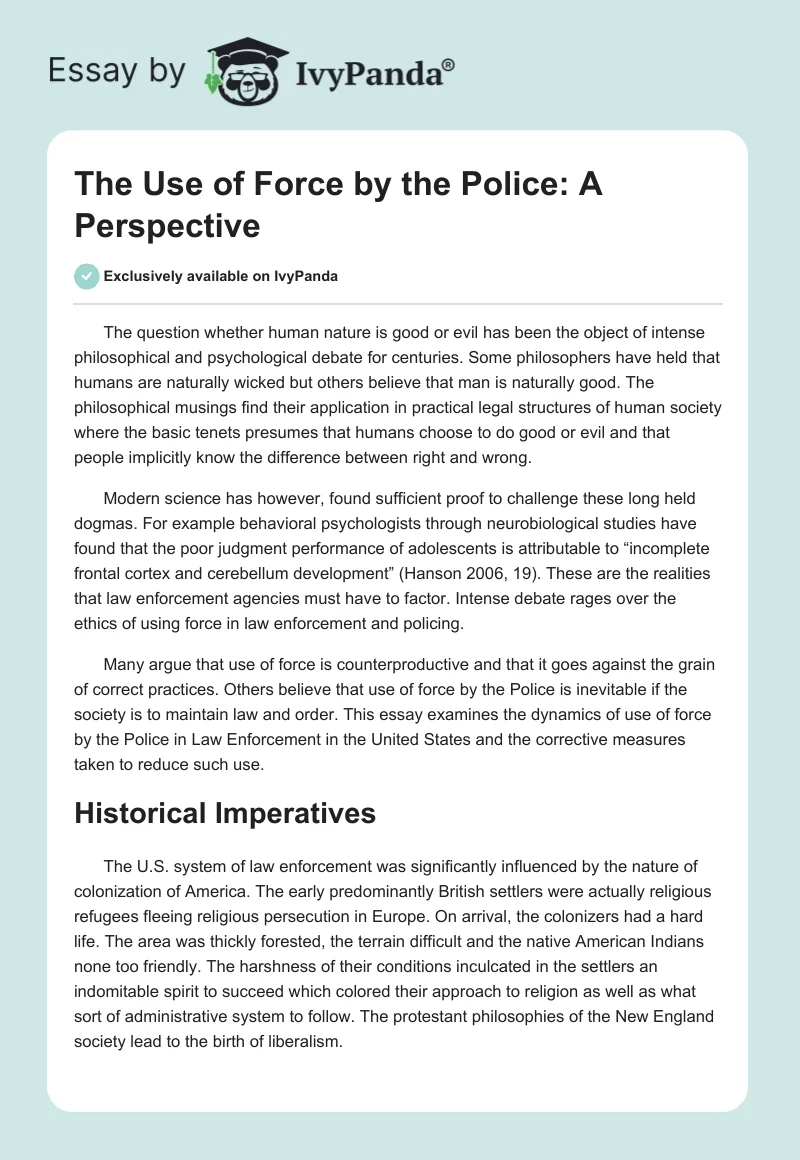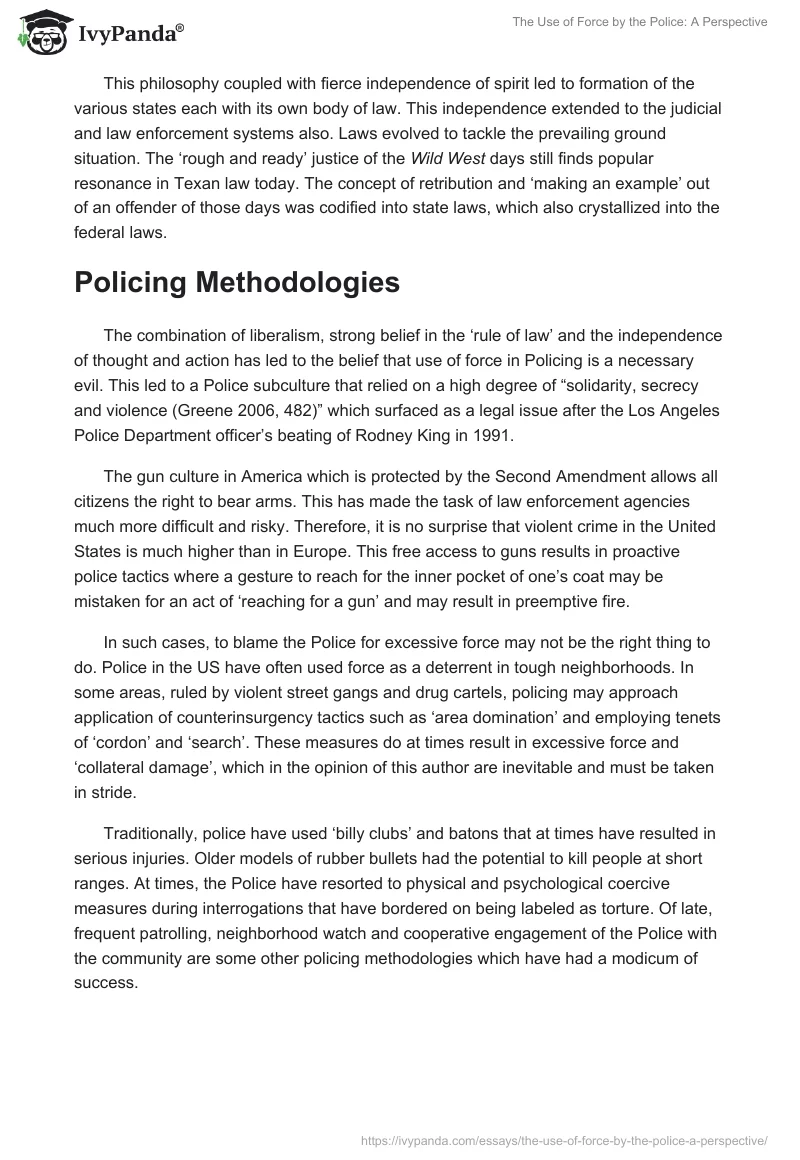The question whether human nature is good or evil has been the object of intense philosophical and psychological debate for centuries. Some philosophers have held that humans are naturally wicked but others believe that man is naturally good. The philosophical musings find their application in practical legal structures of human society where the basic tenets presumes that humans choose to do good or evil and that people implicitly know the difference between right and wrong.
Modern science has however, found sufficient proof to challenge these long held dogmas. For example behavioral psychologists through neurobiological studies have found that the poor judgment performance of adolescents is attributable to “incomplete frontal cortex and cerebellum development” (Hanson 2006, 19). These are the realities that law enforcement agencies must have to factor. Intense debate rages over the ethics of using force in law enforcement and policing.
Many argue that use of force is counterproductive and that it goes against the grain of correct practices. Others believe that use of force by the Police is inevitable if the society is to maintain law and order. This essay examines the dynamics of use of force by the Police in Law Enforcement in the United States and the corrective measures taken to reduce such use.
Historical Imperatives
The U.S. system of law enforcement was significantly influenced by the nature of colonization of America. The early predominantly British settlers were actually religious refugees fleeing religious persecution in Europe. On arrival, the colonizers had a hard life. The area was thickly forested, the terrain difficult and the native American Indians none too friendly. The harshness of their conditions inculcated in the settlers an indomitable spirit to succeed which colored their approach to religion as well as what sort of administrative system to follow. The protestant philosophies of the New England society lead to the birth of liberalism.
This philosophy coupled with fierce independence of spirit led to formation of the various states each with its own body of law. This independence extended to the judicial and law enforcement systems also. Laws evolved to tackle the prevailing ground situation. The ‘rough and ready’ justice of the Wild West days still finds popular resonance in Texan law today. The concept of retribution and ‘making an example’ out of an offender of those days was codified into state laws, which also crystallized into the federal laws.
Policing Methodologies
The combination of liberalism, strong belief in the ‘rule of law’ and the independence of thought and action has led to the belief that use of force in Policing is a necessary evil. This led to a Police subculture that relied on a high degree of “solidarity, secrecy and violence (Greene 2006, 482)” which surfaced as a legal issue after the Los Angeles Police Department officer’s beating of Rodney King in 1991.
The gun culture in America which is protected by the Second Amendment allows all citizens the right to bear arms. This has made the task of law enforcement agencies much more difficult and risky. Therefore, it is no surprise that violent crime in the United States is much higher than in Europe. This free access to guns results in proactive police tactics where a gesture to reach for the inner pocket of one’s coat may be mistaken for an act of ‘reaching for a gun’ and may result in preemptive fire.
In such cases, to blame the Police for excessive force may not be the right thing to do. Police in the US have often used force as a deterrent in tough neighborhoods. In some areas, ruled by violent street gangs and drug cartels, policing may approach application of counterinsurgency tactics such as ‘area domination’ and employing tenets of ‘cordon’ and ‘search’. These measures do at times result in excessive force and ‘collateral damage’, which in the opinion of this author are inevitable and must be taken in stride.
Traditionally, police have used ‘billy clubs’ and batons that at times have resulted in serious injuries. Older models of rubber bullets had the potential to kill people at short ranges. At times, the Police have resorted to physical and psychological coercive measures during interrogations that have bordered on being labeled as torture. Of late, frequent patrolling, neighborhood watch and cooperative engagement of the Police with the community are some other policing methodologies which have had a modicum of success.
Defining Excessive Force
It is very difficult to define what constitutes excessive force. Force has been defined “as the exertion of power to compel or restrain the behavior of other (Greene, 483)”. However, how much power is justified and reasonable and how much could be termed as ‘excessive’ is difficult to legally define. Others have defined excessive force as “violence of a degree that is more than necessary to affect a legitimate police function” (Greene, 483).
Such definitions too do not resolve legal tangles and the best yardstick may well be a resort to ‘common sense’. Here one needs to divert from the legalistic approach and dwell more on the pragmatic approach wherein, it is presumed that most normal people know what the ‘right thing to do’ is. Using excessive force under mitigating circumstances have well known precedence and no legal agency would prosecute a policeman who exercises the right judgment, which at times may result in grievous injury or death of the person being subdued.
In Portland in 1985, the standard police subduing technique of using a ‘carotid artery hold’ resulted in the death of the person being subdued (Thornton and Endo 1992, 58). This use of force was then subsequently changed to incapacitate by using non lethal mace. Since it is difficult to define excessive force, law enforcement agencies have sought to make changes in the hardware and operational methodologies of policing to reduce the chances of excessive force being exercised.
The Efficacy of the ‘Iron Fist’ Versus the ‘Velvet Glove’
American Law Enforcement policies have traditionally taken a hard line stance, ‘the iron fist’ policy against perpetrators of crime compared to European agencies. A comparison of their crime statistics can give an assessment of the relative efficacy of the differing policies. “USA has markedly higher than average levels of violent crimes (Stenson and Cowell 1991, 3)”. America incarcerates people at a rate five to nine times greater than its peer nations (Burd-Sharps, et al. 2008, 142).
Evidently, the European nations have certain policies which have resulted in better success in keeping crime rates low. In Europe, the Police force employs the ‘Velvet Glove’ technique. The emphasis is on early intervention especially in case of juveniles. By early intervention, the community, the Police and the social workers identify the vulnerable individuals who are most likely to take up a life of crime. Having identified such individuals, the community then puts into place measures to prevent those individuals from falling wayside by providing them education, jobs and other avenues to utilize their energies.
Measures to Reduce Excessive Force
One of the major initiatives undertaken by law enforcement agencies across all states in America has been to equip their police personnel with non lethal weapons and provide clear guidelines for their use. These non-lethal weapons cover the entire range from better designed batons, nonlethal mace, tear gas, water cannons, Tazers (Steverson 2007, 37), nets and acoustic devices. At the operational level, Law Enforcement agencies have sought to employ preventive measures such as preventive arrests in domestic violence cases so that the stage wherein excessive force becomes inevitable is reduced or obviated.
Measures such as better street lighting, more surveillance cameras as well as a higher frequency of patrolling add to the deterrent effect and reduce the need for using excessive force. Administrative measures have included sensitization of the police force, better racial mix and decentralization of operations giving mid-level managers greater responsibility and accountability (Skogan and Frydl 2004, 83).
This accountability has been codified in certain instances which have resulted in far lesser incident of excessive force being used. However, no measure can succeed without the active participation and trust of the community. Skogan and Frydl succinctly capture this sentiment by stating that “The more lawful the police are, the more likely the outcomes produced by their actions will be accepted and embraced by the public (6)”. Better interaction and cooperation with the community is the key to better policing. Early intervention and European ‘Velvet Glove’ techniques could be adapted to the American environment for reducing the need to use force.
In conclusion it can be stated that the use of force may be inevitable under certain circumstances. However, law enforcement agencies need to evolve coping and ameliorative strategies to reduce the probability of using such force. Such strategies would involve the entire range of legal, administrative, operational and social transformation to credibly address the issue of use of Force by the Police.
Bibliography
Burd-Sharps, Sarah, Kristen Lewis, Eduardo Borges Martins, and Social Science Research Council (US). 2008.The Measure of America: American Human Development Report, 2008-2009. NY: Columbia University Press.
Greene, Jack R. 2006.The Encyclopedia of Police Science, 3rd edn. Boca Raton: CRC Press.
Hanson, Michael J. “Towards a New Assumption in Law and Ethics.” The Humanist, 2006: 18-21.
Skogan, Wesley G, and Kathleen Frydl. 2004. Fairness and Effectiveness in Policing: The Evidence. Washington D.C.: National Academies Press.
Stenson, Kevin, and David Cowell. 1991 The Politics of Crime Control. New Castle: SAGE.
Steverson, Leonard A. 2007 Policing in America: a Reference Handbook. Santa Barbara: ABC-CLIO.
Thornton, Robert Y, and Katsuya Endo. 1992. Preventing Crime in America and Japan. NY: M.E. Sharpe.


